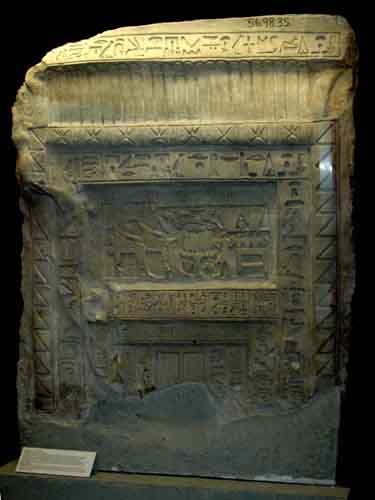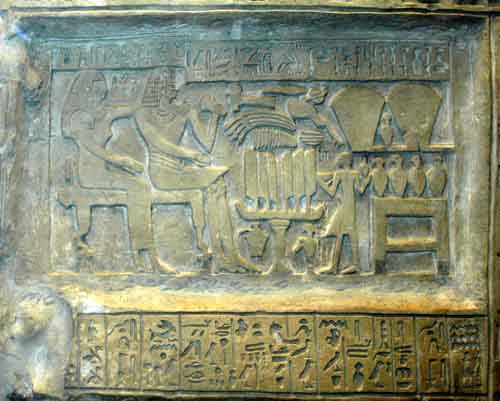 Limestone false door of Sennedjsui, dating to the 9th Dynasty
from Dendera (north of Thebes).
Limestone false door of Sennedjsui, dating to the 9th Dynasty
from Dendera (north of Thebes).
Sennedjsui held various offices and those mentioned here are Sole Friend of the King, Treasurer of the King of Lower Egypt and Overseer of the House (management of an estate). The door shows him sitting on the left with his wife (whom he loves, Sole Royal Ornament Priestess of Hathor) Luwty behind him. On the right of the offering table stands the Director of Dining Tent (the butler) Nebay.
The false door, which was symbolic only, served a similar purpose to a stela. Offerings could be left in front of it for the owner of the tomb. Should no offerings be left then the inscriptions and scenes on the door would become the offerings of eternity.
The late Old Kingdom and the 1st Intermediate Period (7th to 10th Dynasties) were a time of strife. The Old Kingdom state collapsed. Egypt simultaneously suffered political failure and environmental disaster. There was famine, civil disorder and a rise in the death rate. With the climate of Northeast Africa becoming dryer, combined with low inundations of the Nile and the cemeteries rapidly filling, this was not a good time for the Egyptians. The years following the death of Pepy II are most obscure. There are no contemporary records but Herodotus wrote of a Queen Nitokris:
"She killed hundreds of Egyptians to avenge the king, her brother, whom his subjects had killed, and had forced her to succeed. She did this by constructing a huge underground chamber. Then invited to a banquet all those she knew to be responsible for her brother's death. When the banquet was underway, she let the river in on them, through a concealed pipe. After this fearful revenge, she flung herself into a room filled with embers, to escape her punishment."
-
For a time petty princes ruled the
provinces. From Herakleopolis emerged a ruling family led by Khety,
who for a time held sway over the whole country. However, this was
short lived and the country split into North (ruled from
Herakleopolis) and south (ruled from Thebes). The Theban dynasty was
stable, but in Herakleopolis the kings succeeded one another
rapidly. There was continual conflict between the two lands, which
was resolved in the 11th dynasty.
